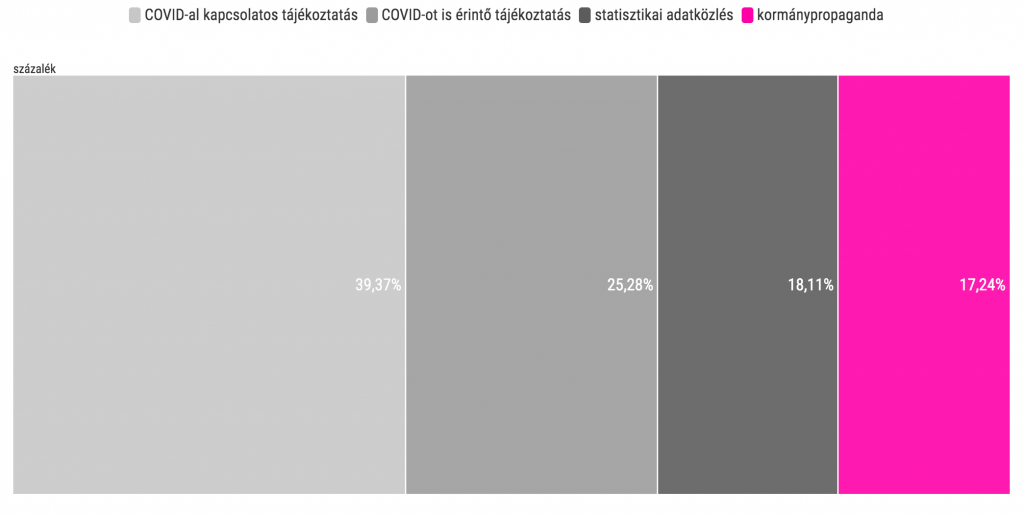The https://english.atlatszo.hu use cookies to track and profile customers such as action tags and pixel tracking on our website to assist our marketing. On our website we use technical, analytical, marketing and preference cookies. These are necessary for our site to work properly and to give us inforamation about how our site is used. See Cookies Policy
Every sixth entry on the government’s official pandemic information page is propaganda
We gathered and analyzed all of the entries on government’s official pandemic information page up to November 13th.

Most countries use their official pandemic information page in order to share data, graphs, and maps, as well as to inform the public of various measures that the government is undertaking in order to fight the pandemic. In terms of both the quality and quantity of pandemic related data and information, Hungary has significantly lagged behind other countries in the region, and it is fair to say that the government has been at war with data since the beginning of the pandemic.
However, the official information shared by the Hungarian government is exceptional in one respect: mixed in with announcements sharing daily figures and the rollout of new government measures, there is also a remarkable amount of propaganda. In these articles, the site shares the real or fabricated successes of the government in matters not related to the pandemic and launches polemics against migrants, the EU, or other supposed enemies.
According to data provided by Similarweb, Koronavirus.gov.hu has had an average of ten million visits per month since March, i.e. a total of 75-80 million since the beginning of the pandemic. Clearly, it’s not inconsequential what kind of content is posted on the official site.
We analyzed all of the posts on the site between March 4th and November 13th – as of November 13th there have been a total of 2286. We sorted these posts into four categories: 1. statistical information, 2. information about the pandemic, 3. information related to the pandemic, 4. government propaganda.
Every sixth post is propaganda
While the majority of the posts share statistical information, and information about or related to the pandemic, of the 2286 entries to date, a total of 394 is government propaganda, in other words, every sixth post.
We labeled as propaganda those posts which clearly reflected the government’s political views. However, we also included posts whose content had no connection with the pandemic or with government action related to the pandemic, but which were nevertheless included on the government’s official coronavirus information page.
Only some of these articles consisted of completely open propaganda, but the majority start out sharing seemingly routine pandemic news when suddenly the official source cited in the article would start attacking the opposition, one of the Soros financed NGOs, or the EU and Brussels (raising fears of Dutch domination or proclaiming that Hungary and Poland had safeguarded their national pride). The reverse also occurred, wherein a topic unrelated to the pandemic would be the primary subject of the article, and an obligatory mention would be made to the coronavirus; for example, a piece about Péter Szijjártó’s (the Minister of Foreign Affairs and Trade) visit to a factory where he spoke about various economic success.
Another good example of these kinds of posts is Katalin Novák’s (Minister for Family Affairs) announcements about CSOK, the family housing subsidy scheme which forms part of the Hungarian government’s effort to combat population decline. Occasionally, there will be a perfunctory comment noting that the pandemic cannot be allowed to interrupt family support; however, for the most part, coronavirus is not even mentioned in these articles.
There were also a few trends in the style of the government propaganda; in particular, the instrumental emphasis of news depending on whether it could be used to disparage the opposition or defend the image of the government. For example, when the situation in the Pest Street Nursing Home deteriorated, the government website took every opportunity to attack Gergely Karácsony, Budapest’s opposition mayor. Furthermore, only a few days after Gergely Karácsony’s announcement that the capital would begin a testing program for public school staff financed through the municipal budget, the website posted a statement from the National Center for Public Health which claimed that the rapid antigen test is not suitable for mass testing. On the other hand, when the media reported on economic difficulties, the website released a series of posts praising the strength and resilience of the Hungarian economy.
This supposedly official and unbiased coronavirus informational website also contains a total of seven communications which attempted to connect migration with the pandemic, Orbán’s favorite political hobby horse.
Many believe that the statistical data provided by the site is itself propaganda, alleging that the site publishes selectively touched up data. However, there is no proof of this; anomalies in the data could be attributable to human error or to problems with the data collection methodology.
It is also difficult to judge the COVID-19 Taskforce’s daily briefings. The Taskforce rarely responds to journalists’ questions, and in the rare case that they do take questions, they tend to prevaricate rather than give a transparent response. First they deny the “availability” of data on the demographic breakdown of COVID-19 patients, then a week later they make claims based on the very same “unavailable” data, and a week after that, they present the data itself. Decide for yourself what you would call this.
Szijjártó’s name appeared most often in the articles
We also analyzed who were the ones who often talked in the articles. Péter Szijjártó (the Minister of Foreign Affairs and Trade) appeared altogether in 184 entries on the coronavirus informational website. He was followed by Cecília Müller (the Chief Medical Officer) with 134 appearances and Viktor Orbán (the Prime Minister) who appeared in 99 entries. Among the twenty person who were featured in the articles oftenly there were only three doctors: Cecília Müller, Miklós Kásler (the Human Resources Minister) and János Szlávik (Hungary’s chief epidemologist).
The economy is the central theme
Not counting communications sharing national and international pandemic data, the economy was by far the most mentioned topic – or, to be more exact, it’s defense through various policy measures. In general, the idea of “defending” against various threats was at the heart of government communication.
What’s the takeaway? It has long been clear that the Hungarian government’s official communications about the pandemic have been a vehicle for propaganda. Despite the fact that a substantial proportion of the site’s visitors are there in order to gather data and information relevant to their own lives, it would have been surprising had the current government not used an official state website which attracts ten million visits per month for propagandistic purposes. The only question has been the volume of said propaganda.
The original article was written by Attila Bátorfy and Zita Szopkó, translated by Milan Kende Loewer


